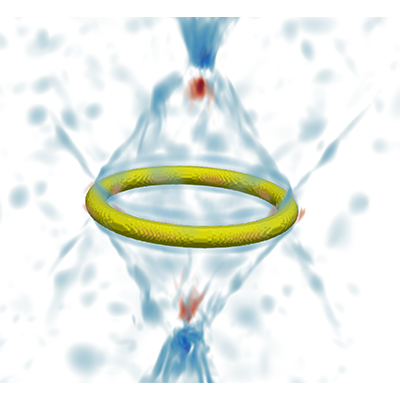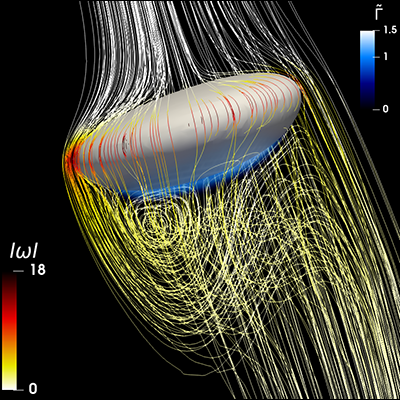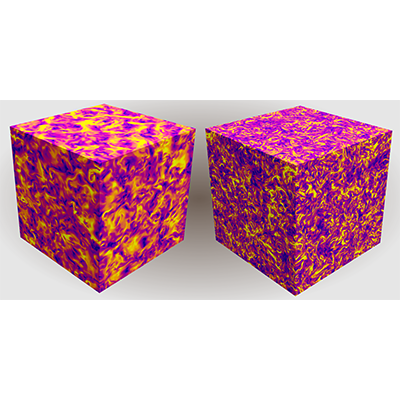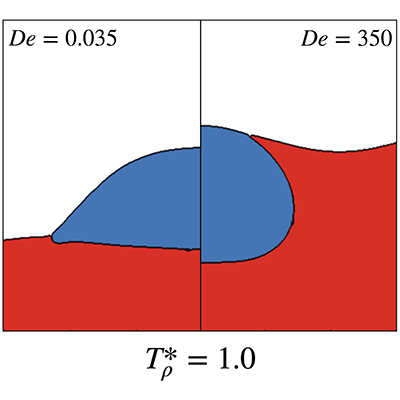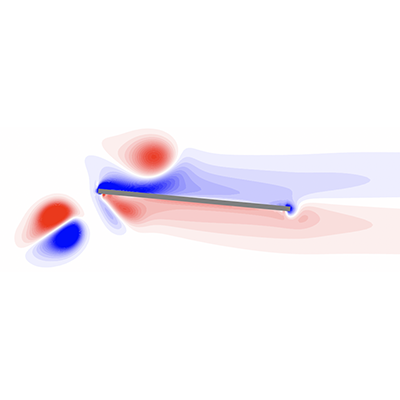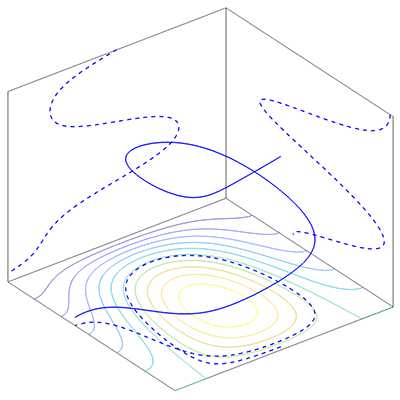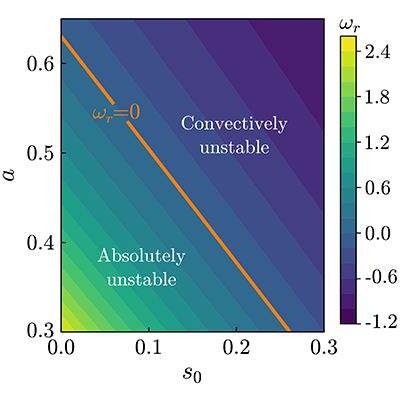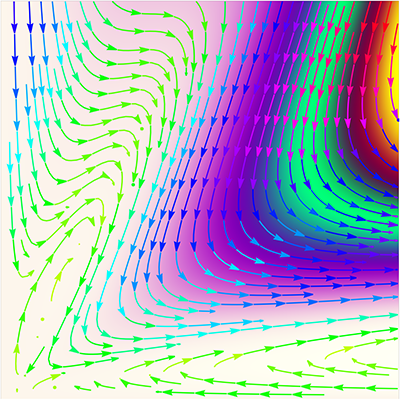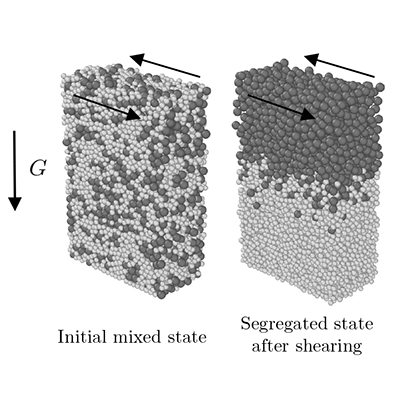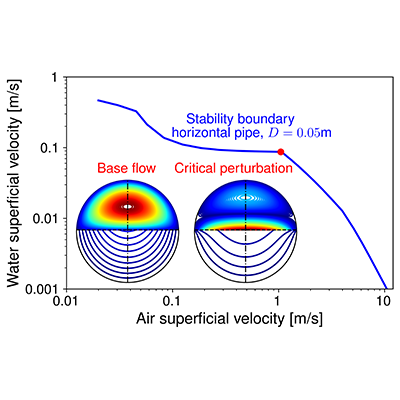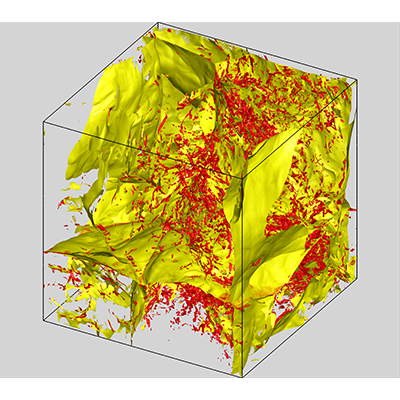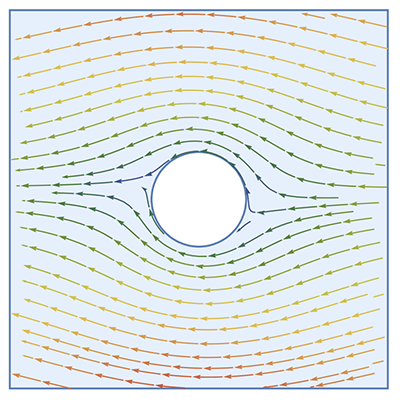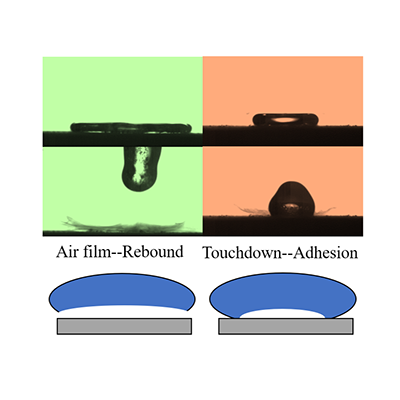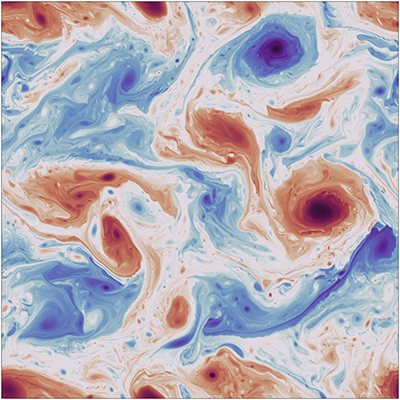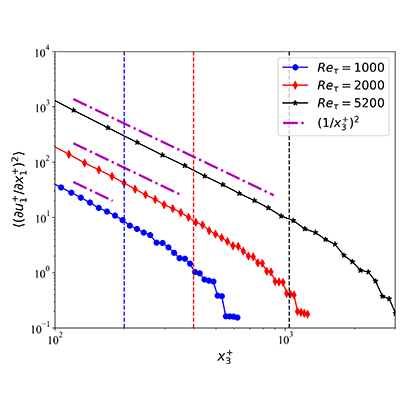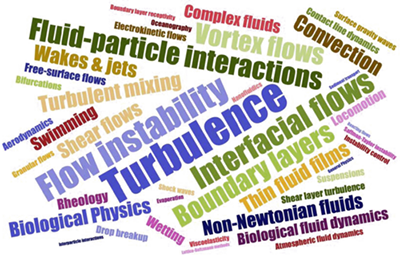NEW ARTICLE
This study investigates the focusing of inertial waves (IW) generated by an axisymmetric torus oscillating in a rotating fluid. A full range of vertical kinetic energy propagation angles at the focal point was explored using direct numerical simulations (DNS). A systematic comparison was made between linear DNS and nonlinear DNS. It was found that there is an optimal angle that maximizes energy transfer from the torus to the focal zone. In addition, triadic IW resonances were identified as a source of turbulence and a large central vertical vortex was also identified in agreement with the theory of Davidson et al. (2006).
A. Mohamed et al.
Phys. Rev. Fluids 9, 094605 (2024)
EDITORS' SUGGESTION
We present an open-source Direct Numerical Simulation framework to analyze surfactant-laden flows. With adaptive mesh refinement and parallelization, this tool enables researchers to explore the effects of surfactants on interfacial flows, particularly their impact on rising bubbles. The simulations show that surfactants slow down bubbles and alter their trajectory. Such numerical frameworks on the solutal Marangoni effect are crucial for understanding and predicting the behavior of multiphase flows in natural and industrial processes.
Palas Kumar Farsoiya, Stéphane Popinet, Howard A. Stone, and Luc Deike
Phys. Rev. Fluids 9, 094004 (2024)
NEW ARTICLE
A universal energy cascade is studied for incompressible ferrofluid turbulence by means of exact relations. Under weak external magnetic field, kinetic and total energy cascades occur at similar rates. Upon increasing the strength of the external magnetic field, the total energy cascade becomes nonstationary and occurs at a rate different from that of the kinetic energy cascade. However, the scale independent nature of the cascade remains universal.
Sukhdev Mouraya, Nandita Pan, and Supratik Banerjee
Phys. Rev. Fluids 9, 094604 (2024)
NEW ARTICLE
Through numerical simulations we reveal the three phase flow as a newtonian droplet comes in contact with an immiscible viscoelastic liquid film. The droplet dynamics becomes insensitive to the film height when the viscoelastic effects dominate. A viscoelastic ridge forms at the moving contact line, which evolves with a power-law dependence on time.
Chunheng Zhao, Taehun Lee, and Andreas Carlson
Phys. Rev. Fluids 9, 094003 (2024)
NEW ARTICLE
This study uses deep reinforcement learning to design airfoil pitch control for minimizing lift variations in disturbed flows. Tested in both classical unsteady and nonlinear viscous flow environments, the reinforcement learning controller, enhanced with wake information from pressure sensors and memory of past observations, matches or exceeds the performance of traditional linear controllers. The findings highlight the potential of reinforcement learning for improved aerodynamic control during random disturbances.
Diederik Beckers and Jeff D. Eldredge
Phys. Rev. Fluids 9, 093902 (2024)
NEW ARTICLE
Only under certain conditions does a drop falling onto a bath entrap an air bubble. We propose a phenomenological law that describes these bubbling conditions in terms of Froude, Weber, and capillary numbers.
Vincent Gourmandie, Juliette Pierre, Valentin Leroy, and Caroline Derec
Phys. Rev. Fluids 9, 094002 (2024)
NEW ARTICLE
Modulational instability is the major energy transfer mechanism between ocean surface waves in deep water. In this work we explore the effects of nonuniform damping, such as that encountered by waves propagating through sea ice, on this important instability. We relax common assumptions about narrow spectral width but are nevertheless able to capture the dynamics of the unstable triad of waves using dynamical systems techniques. We elucidate the differences between uniform and nonuniform damping and explore the consequences for subsequent spectral broadening.
Raphael Stuhlmeier, Conor Heffernan, Alberto Alberello, and Emilian Părău
Phys. Rev. Fluids 9, 094802 (2024)
LETTER
Cavitation near the critical point is unusual because the compressibility becomes very high and the density difference between liquid and vapor becomes small and vanishes completely in the single phase supercritical region. We have investigated laser-induced cavitation in this unusual regime with high speed video at up to 5 million frames per second using liquid helium as the working fluid. Our theoretical analysis shows that the pressure in the liquid outside a bubble can be much lower than the ambient pressure. Near the critical point, the low pressure liquid becomes unstable and generates a cloud of microbubbles, which is consistent with predictions of nucleation theory near the spinodal.
Kenneth R. Langley et al.
Phys. Rev. Fluids 9, L091601 (2024)
NEW ARTICLE
The Rayleigh-Plateau instability occurs when a liquid film flows down a cylindrical surface. Using long-wave theory and stability analysis, we show that this instability can be modulated by coating the cylindrical surface with a thin layer of soft solids. In particular, we find that the elasticity of the soft layer can cause the film flow from being absolutely to convectively unstable. Our findings are also verified by transient numerical solutions of the full asymptotic model.
Youchuang Chao et al.
Phys. Rev. Fluids 9, 094001 (2024)
NEW ARTICLE
To find a blow-up solution to the Euler equations in an infinite domain is related to the zero viscosity limit of the Clay Institute’s sixth Millennium Problem. Evidence of a point-like, self-similar, blow-up solution occurring in an axisymmetric flow with infinite domain is provided by solving a nonlinear eigenvalue problem for a self-similar velocity with an unknown exponent. An angular expansion is used to map the problem into an infinite hierarchy of ODEs, which shows a convergent scenario of solutions for different truncations. This approach suggests an exponent of approximately 2. This solution contrasts with the previously found annular blow-up at a cylindrical domain boundary, which exhibited an exponent of 2.91.
Diego Martínez-Argüello and Sergio Rica
Phys. Rev. Fluids 9, 094401 (2024)
NEW ARTICLE
Dense granular mixtures consisting of particles of different sizes tend to segregate based on size during shear flow, yet predicting the evolution of the composition of a granular mixture in general geometries remains a challenge. This paper systematically studies a key aspect of the three-dimensional nature of segregation and diffusion in dense, bidisperse granular mixtures: segregation and diffusion acting along the direction perpendicular to the plane of shearing, referred to as the anti-plane mode. We utilize discrete-element method simulations to inform, calibrate, and test constitutive equations for the segregation and diffusion fluxes in their anti-plane modes.
Harkirat Singh and David L. Henann
Phys. Rev. Fluids 9, 094301 (2024)
NEW ARTICLE
In this work, the results of a linear stability analysis of air-water stratified flows in horizontal circular pipes are presented. The computed stability boundaries are found to compare well with available experimental data. The stability analysis considered three-dimensional infinitesimal perturbations of all possible wavelengths and took into account deformations of the air-water interface. Comparing stability boundaries obtained in pipe, square duct, and two-plate geometries, it is shown that there are cases where the simplified geometry of two parallel plates can be useful to model the stability boundary in a realistic geometry reasonably well.
Ilya Barmak, Alexander Gelfgat, and Neima Brauner
Phys. Rev. Fluids 9, 093901 (2024)
NEW ARTICLE
To study the evolution of large-scale helical structures in natural and engineering flows, we investigate the dual-channel characteristics of large- scale helicity transfer in compressible turbulent flows theoretically and numerically. Theoretical analysis and well-resolved direct numerical simulations indicate an alternative route to sustain the large-scale helical structures, through the cross-scale interaction at inertial scales and inverse dissipation at small scales under the expansion conditions.
Zheng Yan et al.
Phys. Rev. Fluids 9, 094603 (2024)
NEW ARTICLE
In fluids with broken parity and time-reversal symmetry, odd viscosity introduces the possibility of unique behaviors such as lift force on an obstacle in a symmetric geometry. As incompressible odd viscous fluids are known to not show lift on cylinders under no-slip boundary conditions, this study examines the effect of a finite slip length. While it follows from the Lorentz reciprocal theorem that lift does not arise at first order in slip length, we find that lift does arise at second order upon solving for the fluid profile explicitly. Extending to Oseen flow, we derive a fluid profile that offers new insights into lift force on a cylinder at low Reynolds numbers.
Ruben Lier
Phys. Rev. Fluids 9, 094101 (2024)
LETTER
Dynamic mixed scale-similarity/Smagorinsky type models (DMM) are promising as they typically have a high correlation with subgrid stresses, and provide sufficient subgrid dissipation to be robust for practical applications. However, past DMMs require two or more levels of test filtering, making them unattractive for production codes. We propose an efficient DMM with a single level of test filtering, and through LES tests of turbulent channel flow and wall-modeled LES of turbulent smooth-body separation (see figure, for a Gaussian bump), demonstrate their robustness and improved accuracy with under 5% additional cost compared to the standard Dynamic Smagorinsky Model.
Prahladh S. Iyer and Mujeeb R. Malik
Phys. Rev. Fluids 9, L092601 (2024)
NEW ARTICLE
The rebound of liquid droplets falling on a hot substrate, known as the Leidenfrost phenomenon, is a well-documented and widely studied topic. However, research on the rebound of droplets on cold surfaces, particularly regarding the inverse Leidenfrost phenomenon, remains relatively limited. In this paper, we experimentally investigate the rebound dynamics of droplets on dry ice surfaces, explore the influencing factors of the inverse Leidenfrost phenomenon, and develop a theoretical model to predict its occurrence.
Yao-Jun Li, Yi-Zhou Liu, Yi-Bo Wang, and Min Chen
Phys. Rev. Fluids 9, 093601 (2024)
NEW ARTICLE
Turbulence is by definition an out-of-equilibrium phenomenon, with energy flowing continuously from the large, input scales, to the small, dissipative ones. Temporal fluctuations in this energy flux produce corrections to the Kolmogorov energy spectrum which can be predicted using a multiscale perturbative approach. Here we investigate this problem in the Surface Quasi-Geostrophic model of turbulence, comparing the theoretical predictions with the outcome of high-resolution direct numerical simulations.
V. J. Valadão, T. Ceccotti, G. Boffetta, and S. Musacchio
Phys. Rev. Fluids 9, 094601 (2024)
NEW ARTICLE
From Townsend’s attached-eddy model (AEM), the scalings of velocity moments of attached eddies have been widely investigated in literature. We derive analytically the scalings of the moments of velocity gradients of attached eddies by using the AEM, indicating -2 and -3 scalings for second- and third-order moments respectively, which are in agreement with direct numerical simulation (DNS) data. In addition, non-negligible influences of the small-scale eddies on the velocity gradients in the logarithmic region are discussed.
X. X. Li, R. F. Hu, and L. Fang
Phys. Rev. Fluids 9, 094602 (2024)
